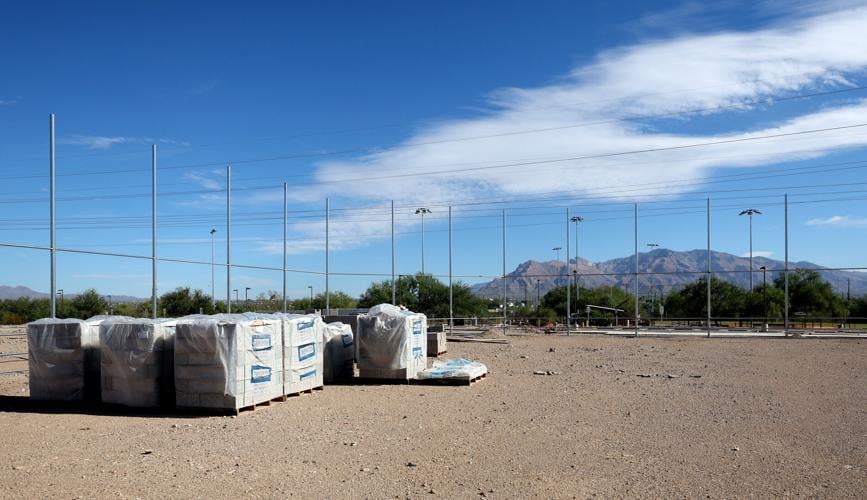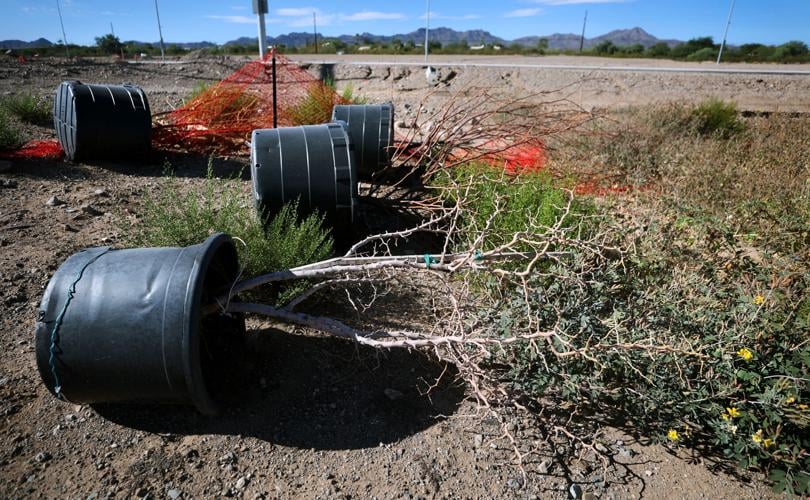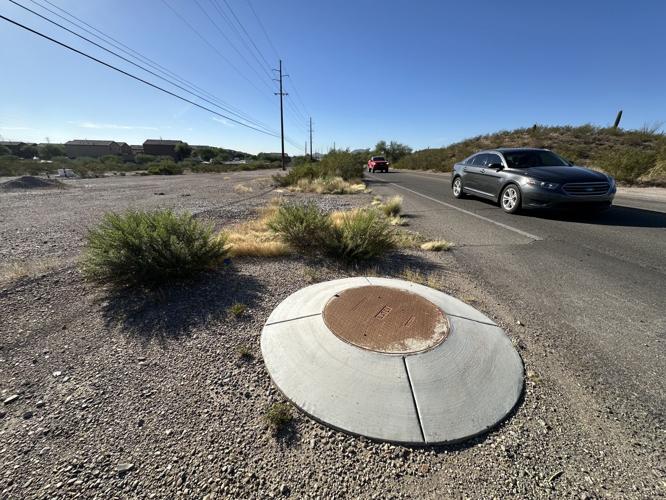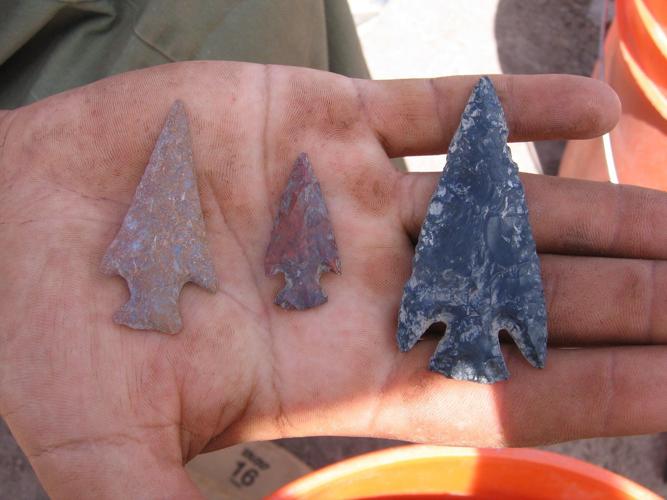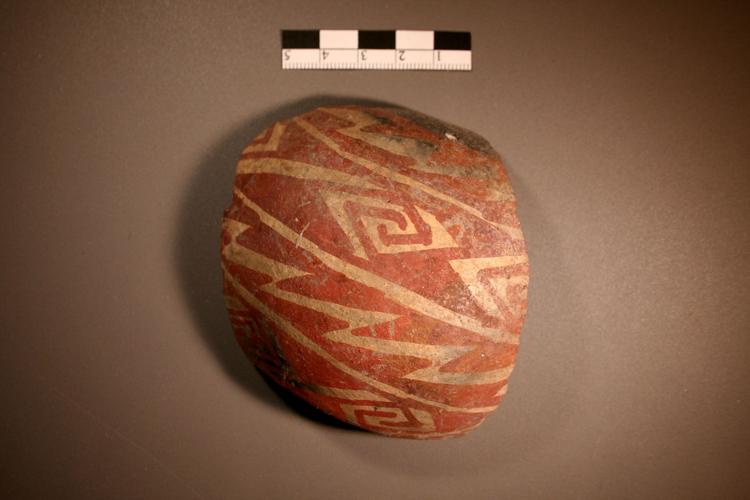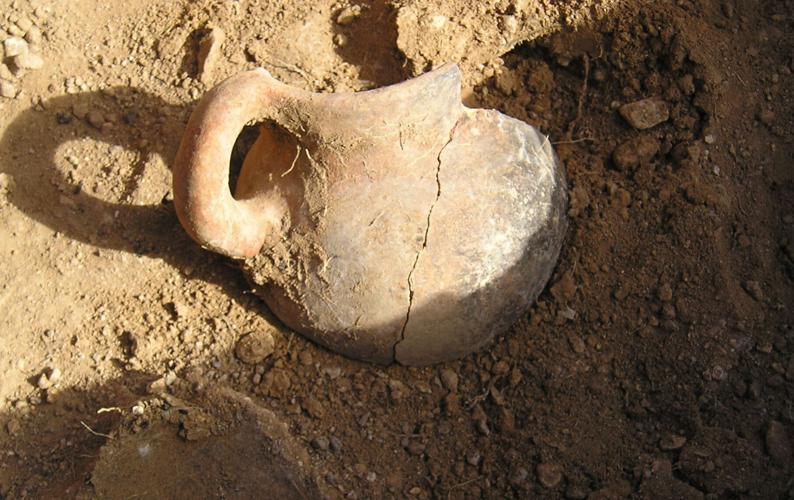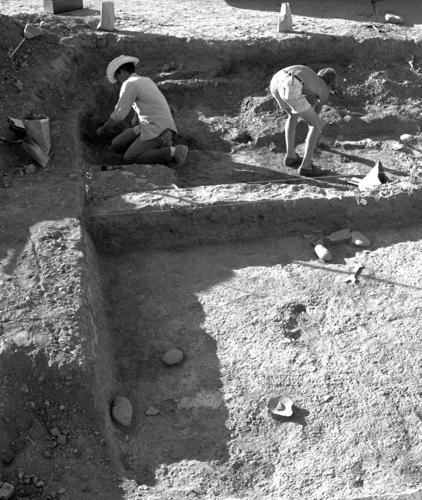Two public works projects on the west side of Tucson have been shut down for months by state and federal authorities, after workers for the city improperly dug through several known archaeological sites near the Santa Cruz River, including one where ancestral Native American remains were later found.

Cement blocks sit at a partially built baseball field backstop at Christopher Columbus Park, after work was halted because the City of Tucson failed to follow regulations designed to protect archaeological sites.
The city’s “unauthorized ground-disturbing activities” occurred during improvements at Christopher Columbus Park earlier this year and water utility work in 2021 for the planned widening of Silverbell Road, according to the U.S. Army Corps of Engineers, the federal permitting agency for activities affecting wetlands and waterways.
The Arizona State Museum issued a stop-work order for the park improvements on June 18, and the Corps of Engineers suspended the city’s federal Clean Water Act permit for the road project on July 9. Both of those orders remain in effect.
Sallie Diebolt, regulatory division chief of the corps’ Arizona branch, detailed the city’s violations in a letter sent last month to several Native American tribes and other consulting parties to the federal permit.
The city has since admitted that it failed to adequately survey for cultural resources prior to construction, then failed to have an archaeological monitor present during the work, in apparent violation of the National Historic Preservation Act and the Arizona Antiquities Act.
In a letter to the Cultural Affairs Office of the Tohono O’odham Nation, Mayor Regina Romero said the city “deeply regrets its mistakes and intends to correct its actions.”
“We take this matter seriously and are committed to resolving it promptly and respectfully, in a way that addresses any harm to your Tribe and its people,” Romero wrote.
City probes ‘breakdowns’
The most recent incident occurred near the corner of Silverbell Road and El Camino Del Cerro, where the city is adding new ball fields and other amenities to Columbus Park.
According to the Corps of Engineers, the city contracted with an archaeological consulting firm to conduct a survey of the property prior to construction, but the assessment only covered about a quarter of the roughly 10-acre area that was scraped and leveled starting in December.

A photo from research and consulting firm Desert Archaeology shows spear points, unearthed along the Santa Cruz River in Tucson, dating back to the Cienega phase, between approximately 800 BC and AD 50.
Though the consulting firm recommended on-site archaeological monitors for all ground-disturbing activity, no monitors were present as the land was graded.
City officials are still investigating “where the breakdowns happened,” said Tucson City Manager Tim Thomure.
There could be some “shared responsibility” among different departments and perhaps an outside contractor or two, he said, but “ultimately the city is responsible for all of it.”
So far, no evidence has been found of any artifacts or remains in the material excavated at the park. But Thomure acknowledged that because the extensive digging was not monitored, “we truly may never know” what might have been buried there.
And it gets worse.
In what city officials acknowledged as a terrible coincidence, much of the dirt and rocks improperly excavated from the park named after Christopher Columbus ended up being trucked to the San Xavier District of the Tohono O’odham Nation, where it was used as fill material for a federally funded housing development.
The tribe was not told in advance where the 118 loads of material came from or how it was excavated. Tohono O’odham officials only found out after it had been layered in place for the housing project.
“We were totally unaware of the situation until after the fact,” said Austin Nunez, San Xavier District chairman for the Tohono O’odham Nation. “I believe it never should have happened, based on everything that is known.”
Archaeological sites fill construction area
The construction site at Columbus Park is located inside one of 11 Archaeological Sensitivity Zones designated by the city because of known concentrations of cultural resources there.
And no wonder. The area along the Santa Cruz River through present-day Tucson has attracted humans for millennia.
Numerous archaeological digs over the past 50 years have yielded the remains of agricultural settlements dotted with pit houses and other structures used for cooking and storage. Typical artifacts found include grinding stones, broken pieces of pottery, chipped-stone tools and the material for making them.

Bruce Huckell, left, and Bruce Bradley excavate the ruins of an ancient Indigenous house during a 1969 archaeological dig west of the Santa Cruz River, near the Pima Animal Care Center.
“That area is filled with archaeological sites,” said University of Arizona anthropology professor Jim Watson, including the ruins of a village that stood near the banks of the river more than 4,000 years ago.
Watson is the associate director and curator of bioarchaeology for the Arizona State Museum, which serves as the permitting authority for archaeological activity on public land under state or local control in Arizona.
He said most of the cultural sites found near Columbus Park and the Silverbell Golf Course date to about 800 years ago, when people now commonly known as the Hohokam built canals and agricultural settlements along the Santa Cruz.
Watson declined to comment on the city’s recent activities in the area, citing the possibility of an open investigation into violations of state historic preservation statutes. But he did say that the evidence of ancient cultures in that particular part of the riparian corridor is generally found buried underground at depths ranging from 15 feet or more in the heart of the floodplain to as little as a foot or two at uphill locations farther from the river.
“In that area of the river corridor, you really run a high risk of running into archaeological resources,” he said. “I would describe it as dense.”
A grave concern
Such sites can also contain cemeteries, Watson said, since the Indigenous residents living here during precolonial times tended to bury their dead within the confines of their villages.
That’s exactly what Desert Archaeology found in 2021, when the Tucson-based consulting firm was hired to conduct a pre-construction investigation along the right-of-way for the Silverbell widening project between Goret Road and El Camino Del Cerro.
According to the Corps of Engineers, Desert Archaeology identified more than 400 cultural features during that work, including “106 mortuary features concentrated in a cemetery located on the south side of Camino de Oeste Wash.”
Based on its findings, the firm warned that more such features were likely to be encountered along the utility corridor and right-of-way.
Though this information was presented to the city in July of that year, the Corps said Tucson Water moved ahead in October with the installation of new underground access vaults for an existing water main along Silverbell Road, without an archaeologist on site at first to monitor the digging.

Traffic moves past a Tucson Water manhole along Silverbell Road near the Silverbell Golf Course on Sept. 18. Infrastructure work by the city in this area in 2022 has been cited by federal authorities for violations of regulations protecting cultural and archaeological resources.
Once city officials discovered the monitoring mistake, they brought Desert Archaeology back to do a damage assessment at the worksite. Thomure said that’s when the consulting firm unearthed human remains and burial items near — but not directly in — the area where Tucson Water had been digging and turned them over to the Arizona State Museum, as required by the firm’s permit with the state.
The museum’s Repatriation Office has since given those ancestral remains and artifacts to the Tohono O’odham, which lays claims to ancient cultural resources found in that area.
Construction site largely abandoned
Early this month, the Corps of Engineers hosted a meeting in Tucson to discuss the permit violations with everyone concerned. The Oct. 1 session included staff from the city, Pima County, the Arizona State Museum, the State Historic Preservation Office, the Tohono O’odham Nation, Pascua Yaqui Tribe, Gila River Indian Community, Salt River Pima-Maricopa Indian Community and the Hopi Tribe.
Thomure chalked up what happened in both cases to a “process failure” by the city. Generally speaking, he said, the way you prevent such errors in the future is by “having better systems in place and better-trained staff.”
Nunez, the San Xavier District chairman, said he hopes the city will do whatever it takes to make sure nothing like this happens again, including beefing up its archaeology staff and improving its communication and coordination with the Tohono O’odham and other tribes.
“I don’t think there was any ill intention by anyone,” he said. “I think it was just a miscommunication all the way around.”

Part of a vessel found in 2008 during an archaeological dig at a site known as Rabid Ruin, east of Silverbell Road near the Pima Animal Care Center.
Nunez added that the tribe’s archaeological staff conducted a visual inspection of the dirt that was delivered to the reservation from Columbus Park, and no cultural items were found. “As far as we’re concerned, I think we’re OK,” he said.
But Thomure said that doesn’t let the city off the hook. Had members of the tribe’s cultural resources team known the source of the fill material beforehand, they almost certainly would have examined it more thoroughly than they did, the city manager said. “They were denied that opportunity because they weren’t informed where it came from.”
The work at Columbus Park includes a new LED-lighted baseball field, two lighted soccer fields, an expanded parking lot and other amenities, which are part of a larger, bond-funded improvement project there that is expected to cost almost $7.2 million.
Since June, though, the construction site has been largely abandoned, leaving open trenches, unfinished sidewalks, pallets of unused bricks, a half-built baseball backstop and dead landscaping trees toppled over in their plastic pots.

Dead landscaping trees still in the their pots lay on the ground at Christopher Columbus Park, after work was halted because the City of Tucson failed to follow regulations designed to protect archaeological sites.
“Stop work means stop work,” Thomure said.
No such order had to be issued for the Silverbell widening project, because there wasn’t any work to stop. The job had not yet gone out to bid when the Corps suspended the city’s permit.

Part of a vessel found in 2008 during an archaeological dig at a site known as Rabid Ruin, east of Silverbell Road near the Pima Animal Care Center.
The voter-approved transportation project involves expanding Silverbell to four lanes from Goret Road to El Camino Del Cerro and adding landscaped medians, bike lanes, improved wash crossings and a separate, paved, multi-use path along the east side of the road. The city’s original plan was to solicit proposals from contractors over the summer and start construction early next year, but Thomure said the start date will almost certainly have to be pushed back.
As for the park expansion, he said he expects that jobsite to sit idle for several more months at least while the city addresses its violations.
“Right now, the priority is not resuming the project,” Thomure said. “The priority is doing everything correctly that is required to make things right.”

A miniature vessel found in 2008 during an archaeological dig at a site known as Rabid Ruin, east of Silverbell Road near the Pima Animal Care Center.


